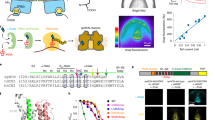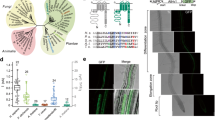Abstract
MVP, a Methanococcus jannaschii voltage-gated potassium channel, was cloned and shown to operate in eukaryotic and prokaryotic cells. Like pacemaker channels, MVP opens on hyperpolarization using S4 voltage sensors like those in classical channels activated by depolarization. The MVP S4 span resembles classical sensors in sequence, charge, topology and movement, traveling inward on hyperpolarization and outward on depolarization (via canaliculi in the protein that bring the extracellular and internal solutions into proximity across a short barrier). Thus, MVP opens with sensors inward indicating a reversal of S4 position and pore state compared to classical channels. Homolo-gous channels in mammals and plants are expected to function similarly.
This is a preview of subscription content, access via your institution
Access options
Subscribe to this journal
Receive 12 print issues and online access
$209.00 per year
only $17.42 per issue
Buy this article
- Purchase on Springer Link
- Instant access to full article PDF
Prices may be subject to local taxes which are calculated during checkout







Similar content being viewed by others
References
Woese, C.R., Kandler, O. & Wheelis, M.L. Towards a natural system of organisms: proposal for the domains Archaea, Bacteria and Eucarya. Proc. Natl. Acad. Sci. USA 87, 4576–4579 (1990).
Bult, C.J. et al. Complete genome sequence of the methanogenic archaeon, Methanococcus jannaschii. Science 273, 1058–1073 (1996).
Zhou, M., Morais-Cabral, J.H., Mann, S. & MacKinnon, R. Potassium channel receptor site for the inactivation gate and quaternary amine inhibitors. Nature 411, 657–661 (2001).
Jiang, Y.X. et al. Crystal structure and mechanism of a calcium-gated potassium channel. Nature 417, 515–522 (2002).
Ren, D. et al. A prokaryotic voltage-gated sodium channel. Science 294, 2372–2375 (2001).
Hodgkin, A.L. & Huxely, A.F. A quantitative description of membrane current and its application to conduction and excitation in nerve. J. Physiol. (Lond.) 117, 500–544 (1952).
Sigworth, F.J. Voltage gating of ion channels. Q. Rev. Biophys. 27, 1–40 (1994).
Hoshi, T., Zagotta, W.N. & Aldrich, R.W. Shaker potassium channel gating. I: Transitions near the open state. J. Gen. Physiol. 103, 249–278 (1994).
Yang, N. & Horn, R. Evidence for voltage-dependent S4 movement in sodium channels. Neuron 15, 213–218 (1995).
Yang, N., George, A.L. Jr. & Horn, R. Molecular basis of charge movement in voltage-gated sodium channels. Neuron 16, 113–122 (1996).
Seoh, S.A., Sigg, D., Papazian, D.M. & Bezanilla, F. Voltage-sensing residues in the S2 and S4 segments of the Shaker K+ channel. Neuron 16, 1159–1167 (1996).
Larsson, H.P., Baker, O.S., Dhillon, D.S. & Isacoff, E.Y. Transmembrane movement of the Shaker K+ channel S4. Neuron 16, 387–397 (1996).
Starace, D.M., Stefani, E. & Bezanilla, F. Voltage-dependent proton transport by the voltage sensor of the Shaker K+ channel. Neuron 19, 1319–1327 (1997).
Yellen, G. The moving parts of voltage-gated ion channels. Q. Rev. Biophys. 31, 239–295 (1998).
Bezanilla, F. The voltage sensor in voltage-dependent ion channels. Physiol. Rev. 80, 555–592 (2000).
Starace, D.M. & Bezanilla, F. Histidine scanning mutagenesis of basic residues of the S4 segment of the Shaker K+ channel. J. Gen. Physiol. 117, 469–490 (2001).
Santoro, B. et al. Identification of a gene encoding a hyperpolarization-activated pacemaker channel of brain. Cell 93, 717–729 (1998).
Ludwig, A. et al. Two pacemaker channels from human heart with profoundly different activation kinetics. EMBO J. 18, 2323–2329 (1999).
Seifert, R. et al. Molecular characterization of a slowly gating human hyperpolarization-activated channel predominantly expressed in thalamus, heart, and testis. Proc. Natl. Acad. Sci. USA 96, 9391–9396 (1999).
Anderson, J.A., Huprikar, S.S., Kochian, L.V., Lucas, W.J. & Gaber, R.F. Functional expression of a probable Arabidopsis thaliana potassium channel in Saccharomyces cerevisiae. Proc. Natl. Acad. Sci. USA 89, 3736–3740 (1992).
Zei, P.C. & Aldrich, R.W. Voltage-dependent gating of single wild-type and S4 mutant KAT1 inward rectifier potassium channels. J. Gen. Physiol. 112, 679–713 (1998).
Chen, J., Mitcheson, J.S., Lin, M. & Sanguinetti, M.C. Functional roles of charged residues in the putative voltage sensor of the HCN2 pacemaker channel. J. Biol. Chem. 275, 36465–36471 (2000).
Shin, K.S., Rothberg, B.S. & Yellen, G. Blocker state dependence and trapping in hyperpolarization-activated cation channels: evidence for an intracellular activation gate. J. Gen. Physiol. 117, 91–101 (2001).
Rothberg, B.S., Shin, K.S., Phale, P.S. & Yellen, G. Voltage-controlled gating at the intracellular entrance to a hyperpolarization-activated cation channel. J. Gen. Physiol. 119, 83–91 (2002).
Mannikko, R., Elinder, F. & Larsson, H.P. Voltage-sensing mechanism is conserved among ion channels gated by opposite voltages. Nature 419, 837–841 (2002).
Schlosser, A., Meldorf, M., Stumpe, S., Bakker, E.P. & Epstein, W. TrkH and its homolog, TrkG, determine the specificity and kinetics of cation transport by the Trk system of Escherichia coli. J. Bacteriol. 177, 1908–1910 (1995).
Ahmed, A. et al. A molecular target for viral killer toxin: TOK1 potassium channels. Cell 99, 283–291 (1999).
Sesti, F., Shih, T.M., Nikolaeva, N. & Goldstein, S.A. Immunity to K1 killer toxin: internal TOK1 blockade. Cell 105, 637–644 (2001).
Ketchum, K.A., Joiner, W.J., Sellers, A.J., Kaczmarek, L.K. & Goldstein, S.A.N. A new family of outwardly-rectifying potassium channel proteins with two pore domains in tandem. Nature 376, 690–695 (1995).
Saimi, Y., Loukin, S.H., Zhou, X.L., Martinac, B. & Kung, C. Ion channels in microbes. Methods Enzymol. 294, 507–524 (1999).
Zerangue, N., Schwappach, B., Jan, Y.N. & Jan, L.Y. A new ER trafficking signal regulates the subunit stoichiometry of plasma membrane K(ATP) channels. Neuron 22, 537–548 (1999).
Chen, G.Q., Cui, C., Mayer, M.L. & Gouaux, E. Functional characterization of a potassium-selective prokaryotic glutamate receptor. Nature 402, 817–821 (1999).
Spector, P.S., Curran, M.E., Zou, A., Keating, M.T. & Sanguinetti, M.C. Fast inactivation causes rectification of the IKr channel. J. Gen. Physiol. 107, 611–619 (1996).
Smith, P.L., Baukrowitz, T. & Yellen, G. The inward rectification mechanism of the HERG cardiac potassium channel. Nature 379, 833–836 (1996).
Chen, S., Wang, J. & Siegelbaum, S.A. Properties of hyperpolarization-activated pacemaker current defined by coassembly of HCN1 and HCN2 subunits and basal modulation by cyclic nucleotide. J. Gen. Physiol. 117, 491–504 (2001).
Kaupp, U.B. & Seifert, R. Molecular diversity of pacemaker ion channels. Annu. Rev. Physiol. 63, 235–257 (2001).
DiFrancesco, D. Characterization of single pacemaker channels in cardiac sino-atrial node cells. Nature 324, 470–473 (1986).
Hoshi, T. Regulation of voltage dependence of the KAT1 channel by intracellular factors. J. Gen. Physiol. 105, 309–328 (1995).
Hoth, S. Distinct molecular bases for pH sensitivity of the guard cell K+ channels KST1 and KAT1. J. Biol. Chem. 274, 11599–11603 (1999).
del Camino, D., Holmgren, M., Liu, Y. & Yellen, G. Blocker protection in the pore of a voltage-gated K+ channel and its structural implications. Nature 403, 321–325 (2000).
Zheng, J. & Sigworth, F.J. Selectivity changes during activation of mutant Shaker potassium channels. J. Gen. Physiol. 110, 101–117 (1997).
Kiss, L. & Korn, S.J. Modulation of C-type inactivation by K+ at the potassium channel selectivity filter. Biophys. J. 74, 1840–1849 (1998).
Loots, E. & Isacoff, E.Y. Protein rearrangements underlying slow inactivation of the Shaker K+ channel. J. Gen. Physiol. 112, 377–389 (1998).
Kiss, L., LoTurco, J. & Korn, S.J. Contribution of the selectivity filter to inactivation in potassium channels. Biophys. J. 76, 253–263 (1999).
Liu, J. & Siegelbaum, S.A. Change of pore helix conformational state upon opening of cyclic nucleotide-gated channels. Neuron 28, 899–909 (2000).
Flynn, G.E. & Zagotta, W.N. Conformational changes in S6 coupled to the opening of cyclic nucleotide-gated channels. Neuron 30, 689–698 (2001).
Zilberberg, N., Ilan, N. & Goldstein, S.A. KCNKO: opening and closing the 2-P-domain potassium leak channel entails 'C-type' gating of the outer pore. Neuron 32, 635–648 (2001).
Ko, C.H. & Gaber, R.F. TRK1 and TRK2 encode structurally related K+ transporters in Saccharomyces cerevisiae. Mol. Cell. Biol. 11, 4266–4273 (1991).
Goldstein, S.A.N., Price, L.A., Rosenthal, D.N. & Pausch, M.H. ORK1, a potassium-selective leak channel with two pore domains cloned from Drosophila melanogaster by expression in Saccharomyces cerevisiae. Proc. Natl. Acad. Sci. USA 93, 13256–13261 (1996).
Gustin, M.C., Zhou, X.L., Martinac, B. & Kung, C. A mechanosensitive ion channel in the yeast plasma membrane. Science 242, 762–765 (1988).
Acknowledgements
This work was supported by grants to S.A.N.G. from the National Institutes of Health. S.A.N.G. is a Doris Duke Charitable Foundation Distinguished Clinical Scholar Award recipient. We thank R. Goldstein for technical and lexical support.
Author information
Authors and Affiliations
Corresponding author
Ethics declarations
Competing interests
The authors declare no competing financial interests.
Rights and permissions
About this article
Cite this article
Sesti, F., Rajan, S., Gonzalez-Colaso, R. et al. Hyperpolarization moves S4 sensors inward to open MVP, a methanococcal voltage-gated potassium channel. Nat Neurosci 6, 353–361 (2003). https://doi.org/10.1038/nn1028
Received:
Accepted:
Published:
Issue Date:
DOI: https://doi.org/10.1038/nn1028
This article is cited by
-
Electromechanical coupling in the hyperpolarization-activated K+ channel KAT1
Nature (2020)
-
Structure of potassium channels
Cellular and Molecular Life Sciences (2015)
-
Probing S4 and S5 segment proximity in mammalian hyperpolarization-activated HCN channels by disulfide bridging and Cd2+ coordination
Pflügers Archiv - European Journal of Physiology (2009)
-
Orientation of Arabidopsis thaliana KAT1 Channel in the Plasma Membrane
The Journal of Membrane Biology (2004)



